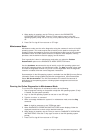
3. The Cstate for each standalone diagnostics client on the NIM server should be kept
in the
diagnostic boot has been enabled
state.
4. On the client system, the NIM server network adapter should be put in the bootlist
after the boot disk drive. This allows the system to boot in standalone diagnostics
from the NIM server if there is a problem booting from the disk drive. Refer to the
Multiboot section under “SMS” in the client system’s service guide for information
on setting the bootlist.
NIM Server Configuration
See the
AIX Installation Guide and Reference
, order number SC23-4389, for
information on doing the following:
v Registering a client on the NIM server
v Enabling a client to run diagnostics from the NIM server
To verify that the client system is registered on the NIM server and the diagnostic boot
is enabled, run the command lsnim -a Cstate -Z
ClientName
from the command line
on the NIM server. Refer to the following table for system responses.
Note: The
ClientName
is the name of the system on which you want to run standalone
diagnostics.
System Response Client Status
#name:Cstate:
ClientName:diagnostic boot has been
enabled:
The client system is registered on the NIM
server and enabled to run diagnostics from the
NIM server.
#name:Cstate:
ClientName:ready for a NIM operation:
or
#name:Cstate:
ClientName:BOS installation has been
enabled:
The client is registered on the NIM server but
not enabled to run diagnostics from the NIM
server.
Note: If the client system is registered on the
NIM server but Cstate has not been set, no
data will be returned.
0042-053 lsnim: there is no NIM object
named "ClientName"
The client is not registered on the NIM server.
90 Eserver pSeries 690 User’s Guide


















